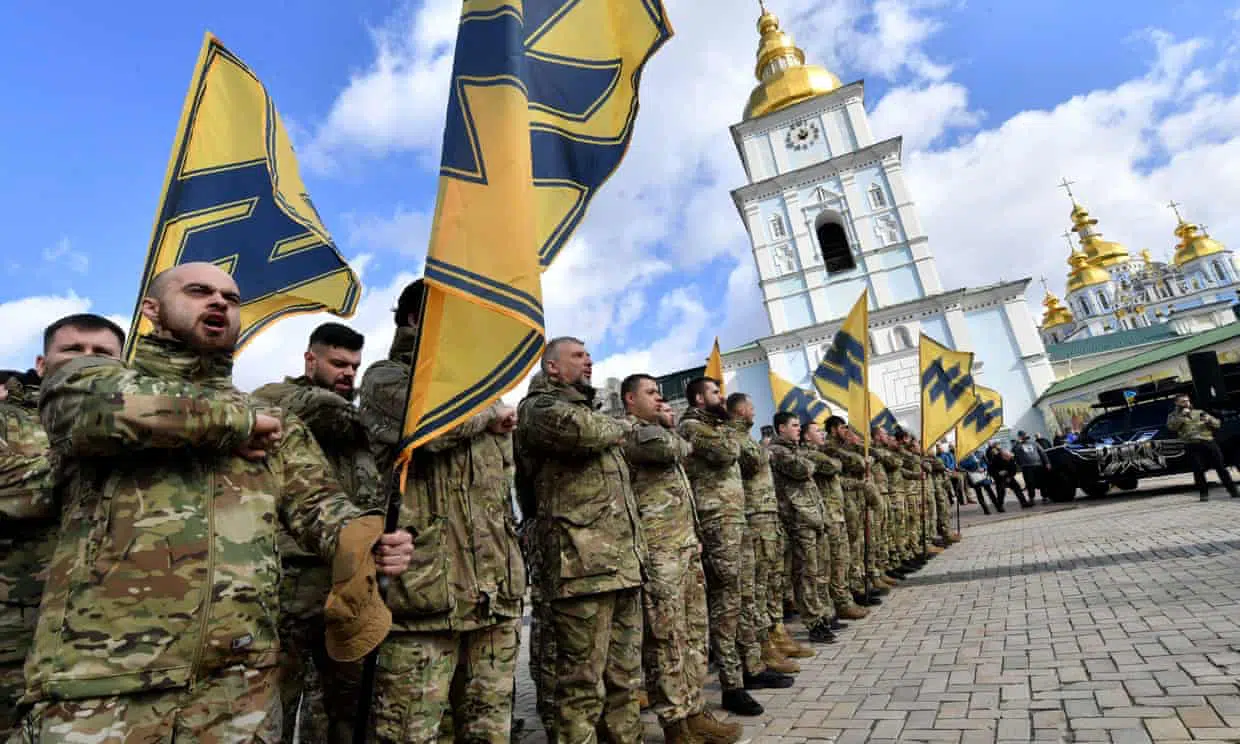UKRAINE
Azov Battalion – Guardian Angels or Notorious Extremists?

Caption: Members of Azov Battalion gathering in Kyiv. Photograph: Sergei Supinsky/Getty
History
Civil unrest took place across Ukraine during the 2014 revolution. This resulted in an overthrow of the elected government led by Viktor Yanukovych. Following the riots, Russia decided to send military units to Crimea and declared the Republic of Crimea and the federal city of Sevastopol as the 84th and 85th federal subjects of Russia. Since then, collisions between pro-Russian separatists and pro-Ukrainian militias have continued.
The Azov Battalion is one of the most well-known military units that emerged during the 2014 Ukrainian crisis. It was initially founded as a voluntary militia in the Azov Sea coastal area. In October 2014, it formally became a branch of the National Guard of Ukraine. The Battalion was first observed on the battleground in Mariupol. Here, they recaptured the town from pro-Russian separatist forces in June 2014. With its rapid growth, Azov Battalion has become an unignorable military force and a tangible icon of Ukrainian patriotism.
Ideology
The Azov Battalion faces accusations claiming its close ties with neo-Nazi ideology when it was first recognized by the international society. In 2014, a German public broadcaster named ZDF released videos showing Azov soldiers wearing helmets with the Nazi Swastika and SS symbols.
The Guardian describes Azov’s symbol as “reminiscent of the Nazi Wolfsangel”, while the battalion denies it by saying it simply represents the letter N and I crossing over each other, implying “National Idea” in the Ukrainian language. Some of Azov’s leaders have been linked to neo-Nazi ideology. Andriy Biletsky, the battalion’s first commander, also leads neo-Nazi organizations “Patriot of Ukraine” and “Social-National Assembly”.
Members of Azov Battalion have attempted to separate themselves from Nazi stereotypes. Instead, they have claimed that the organization is founded upon Ukrainian patriotism. Some of them even take a more “Robin Hood alike” approach, legitimizing their gathering by saying that “the police are ineffective, corrupt or drunk.”
Andriy Diachenko, a spokesman for the Azov Battalion, stated in an interview with USA Today that ‘only 10% to 20% of the group’s members are Nazis’ and it’s all about ‘personal ideology [that] has nothing to do with the official ideology of the Azov.’
The designation of Azov battalion has been controversial internationally. In April 2021, U.S. Representative Elissa Slotkin sent a list of “Violent Extreme Right Wing” (vXRM) organizations to U.S. Secretary of State Antony Blinken, pressing the Biden administration to recognize these groups as “Foreign Terrorist Organizations” (FTOs). The Azov Battalion is included within this. Kacper Rekawek, an affiliated researcher at Counter Extremism Project, denied such an accusation and stated that Azov “does not engage in terrorist activity.”
Furthermore, former FBI officials called members of Azov Battalion “white supremacists” and compared them to “jihadists,” as enemies of the U.S. in a New York Times op-ed. In response, the Atlantic Council published an article written by Anton Shekhovtsov to deny such a claim. Shekhovtsov states that the nature of Azov Battalion has changed over time. This makes it simply a military unit controlled by the state. He also disproved the connection between the American bomber and the Ukrainian organization, claimed by the New York Times op-ed authors.
Recruitment
When Azov Battalion was first formed, it used extremist ideology and comparatively high pays to attract new members. Evolved over time, it has employed multiple new methods to recruit both domestically and internationally. According to published news pieces, foreign fighters from Sweden, Croatia, the United Kingdom, and even Russia joined Azov Battalion.
In an interview with TIME, an Azov recruiter named Joachim Furholm attributes Azov’s successful propaganda efforts to its pervasive use of social media, especially Facebook. Azov recruiters track potential members and support other right-wing organizations on Facebook. Facebook reacted quickly that it announced to ban Azov’s homepage and related accounts first in 2015 over “hate speech”. However, an article published by Buzzfeed News pointed out that advertisements related to Azov Battalion were still observed on Facebook in November 2020.
Additionally, Azov Battalion also run military summer camps domestically. Here, they taught children aged 9-18, military skills such as shooting rifles, practicing combat poses, and patrolling. Kyiv post reported that strict rules and nationalism ideology are practiced in these camps. In a documentary filmed by the Guardian, trainers at the camps teach children to salute to the Azov flag and shout “Ukraine above all”. Geopolitika, an organization based in Russia, accused such camps of ‘inciting hate by innocent children against ethnic Russians as well as opponents of the Kiev regime.” It also states that such acts are “broadly supported by US military aid”.
Conclusion
As a branch of the National Guard of Ukraine, Azov has transformed from a paramilitary organization to a national force. Its efforts to separate itself from the stereotype of “neo-Nazis” have convinced some. However, it still draws a significant number of critics. The designation of the group should be exercised deliberately and apolitically.
No comments:
Post a Comment